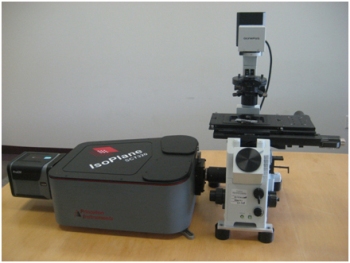Princeton Instruments (Trenton, New Jersey, USA) is pleased to announce the availability of a new microscope interface designed for exclusive use with the company’s recently introduced aberration-free IsoPlane® imaging spectrograph. The Princeton Instruments MicroSpec® microscope interface allows researchers to easily acquire quality images and spectra of their samples with one pre-engineered system.
 IsoPlane spectrograph shown MicroSpec interface and inverted microscope.
IsoPlane spectrograph shown MicroSpec interface and inverted microscope.
The MicroSpec attaches to a UDP port on select Olympus, Nikon, and Zeiss inverted microscopes. The interface is not compatible with any other spectrographs, nor with upright microscopes. It supports all Princeton Instruments cameras with a spectroscopy mount and without an internal shutter. The MicroSpec interface provides outstanding imaging of up to 12 x 12 mm field of view.
Whereas traditional Czerny-Turner (CT) spectrographs suffer from aberrations that degrade imaging performance and spectral quality, particularly at the edges of the focal plane, the IsoPlane SCT 320 spectrograph provides superior imaging and spectra across the focal plane. Thanks to having zero astigmatism and negligible spherical aberration and coma, the image produced at zero order at the focal plane of the IsoPlane is of high quality. The lack of aberrations also means more photons hit fewer pixels, increasing the signal-to-noise ratio of spectra.
“When coupled to a microscope, the IsoPlane can resolve up to 25 line pairs per mm, the Nyquist limit of CCD cameras with 20 micron pixels,” states Ed Gooding, Spectroscopy Product Manager at Princeton Instruments. “The IsoPlane can be used from the vacuum UV to the mid-IR, with software-controlled scanning and an interchangeable triple grating turret. It also supports IntelliCal ™, our state-of-the-art wavelength and intensity calibration package. No other spectrometer on the market offers the IsoPlane’s combination of flexibility, resolution, and extraordinary signal-to-noise ratio”.
Applications of the new MicroSpec-IsoPlane system include fluorescence, Raman, photoluminescence, single-molecule spectroscopy, quantum dots, live-cell imaging, and carbon nanotube SWIR imaging and sum frequency generation.